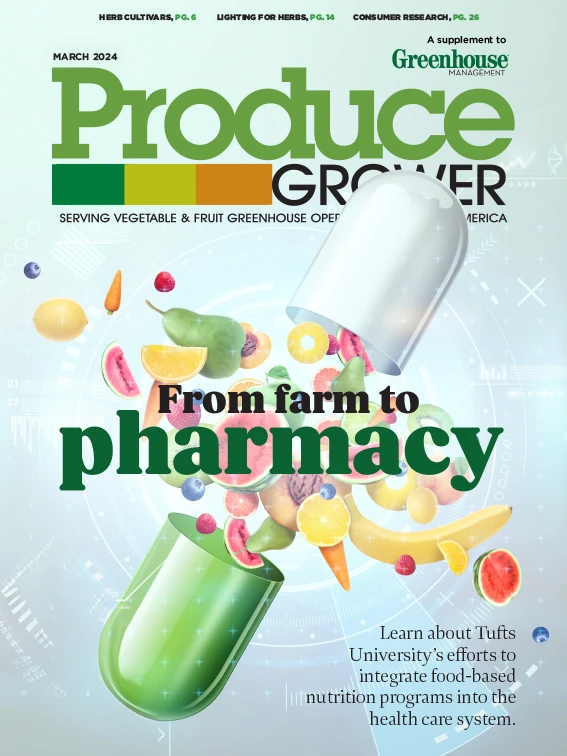
There are many facets of producing culinary herbs in controlled environments. However, the road to producing high-quality culinary herbs and optimizing yields starts early. There are two crucial steps this article is going to cover, including cultivar selection and propagation.
Cultivar selection is one of the most important aspects of producing any food crop, or any crop, for that matter. Crop genetics can affect nearly every aspect of plants, including appearances, growth rates, disease and insect resistance, and — especially for food crops — flavor. For many food crops, including fruiting vine crops (tomato, cucumber and pepper) and lettuce, there are numerous cultivars to select from that have been bred specifically for controlled-environment production. Having this type of selection across different genetics is a major benefit for finding the right fit for your production system and environment, as well as customers. However, this type of controlled-environment selection doesn’t exist for the vast majority of herb cultivars. The biggest exception to this is sweet basil, a species with numerous cultivars available that vary in their characteristics. But for many herb species, it can be hard to count more than two or three cultivars per species. And whether it is basil with dozens of cultivars, or flat leaf parsley with only a few, virtually no herb cultivars have been bred specifically for controlled environment production.
While talking with other producers and reading descriptions of different herb cultivars is helpful, nothing can compare to in-house trials, where you see firsthand which cultivars perform best under your unique conditions. While it may seem like cultivar selection may be a trivial part of the production process, consider this example. Just by using some cultivar trial comparisons, we were able to identify an alternative basil cultivar that had a comparable flavor, but three times the yield. Doing your own research can certainly pay off.
Once you’ve selected the cultivar(s) you want to produce, it’s time to get growing, and it starts in propagation. Culinary herbs can be propagated both sexually by seed or vegetatively through stem-tip cuttings, but propagation by seed is much more prevalent. Seedling propagation is comprised of the germination stage (seed root or radicle emergence and cotyledon expansion) and growth stage (true leaf development and toning). For germination, be sure to prepare rockwool or phenolic foam by rinsing or soaking it to establish the target pH and electrical conductivity (EC) prior to seeding.
While sowing seeds singly is the norm for many food crops, sowing multiple seeds per cell is the norm for herbs. Multi-seeded young plants produce higher yields per square foot per week compared to single-sown plants. And a real benefit is that herb seed is fairly inexpensive, so this is an economical approach. Multi-seeding can be taken too far, as excessively seeded plugs can result in too much stretch and less growth in leaves. Light or dark requirements for germination is species dependent. If seeds require darkness for germination, be sure to get them out of the dark as soon as the radicle emerges to minimize unwanted stretch. A covering over seeds can be used for darkness, but it can also serve other purposes, such as reducing seedling push from the cell and maintain moisture around seed. Air and substrate temperatures should be warm to promote rapid and uniform germination. Once germination is complete, the light intensity should increase, and the air temperature decreases for the growth stages. Similarly, fertilizer concentrations should increase as seedlings are producing true leaves.
Although the majority of culinary herbs are propagated by seed, there are some species such as rosemary, mint, and specialty sages, that may be vegetatively propagated by stem tip cutting. The stages of cutting propagation are somewhat analogous to the different stages of plug production: rooted cuttings arrive or are harvest, callusing, root development, and toning. Managing the environment and culture for rooted cuttings is also very similar, with temperatures and mist/irrigation decreasing and fertilizer and light increasing during propagation.
Whether propagated by seed or cutting, determining when herb young plants are finished is more flexible for plants propagated in stabilized substrates such as rockwool or phenolic foam when compared to young plants propagated in loose substrates. Unlike loose substrate, stabilized substrates don’t require roots to hold the media together. Therefore, seedlings can be transplanted earlier, though they can be transplanted into nursery rafts or channels and don’t necessarily have to go into final spacings earlier.
Alternatively, if the goal is to reduce square foot weeks and time spent at maximum spacings, consider using a larger seedling cube size. Although this can increase time in propagation, consider nursery rafts and channels to save on space and time during finishing.
Taking the time to get started on the right path is worth it in the end. Do not underestimate the power of cultivar selection, especially for herbs at this stage in their development. Propagating healthy young plants, whether by seed or cutting, is another investment early on that will pay dividends in yields.

Explore the March 2024 Issue
Check out more from this issue and find your next story to read.
Latest from Produce Grower
- TIPA Compostable Packaging acquires paper-based packaging company SEALPAP
- Divert, Inc. and General Produce partner to transform non-donatable food into Renewable Energy, Soil Amendment
- [WATCH] Sustainability through the value chain
- Growing leadership
- In control
- The Growth Industry Episode 8: From NFL guard to expert gardener with Chuck Hutchison
- 2025 in review
- WUR extends Gerben Messelink’s professorship in biological pest control in partnership with Biobest and Interpolis





